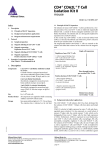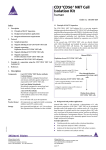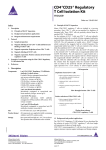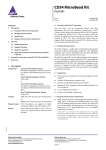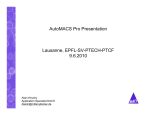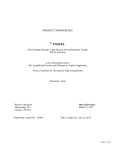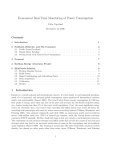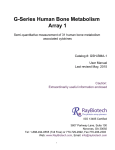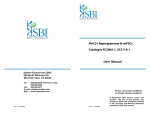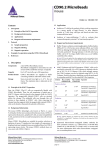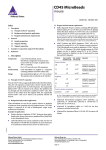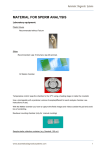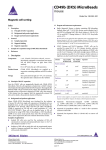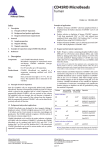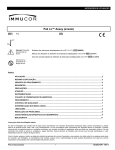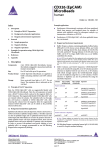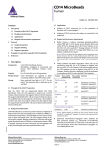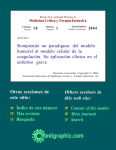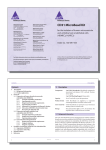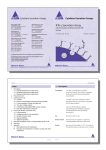Download CD61 MicroBeads - Miltenyi Biotec
Transcript
CD61 MicroBeads human Order no. 130-051-101 Index Examples of applications 1. Description ● CD61+ cells from bone marrow cells are isolated for studies on megakaryocytopoiesis. ● Positive selection or depletion of cells expressing human CD61 antigen. ● Isolation of megakaryocytes from human bone marrow (see: 5. Special cell separation protocol: Megakaryocytes isolation).¹ 1.1 Principle of MACS® Separation 1.2 Background and product applications 1.3 Reagent and instrument requirements 2. Protocol 2.1 Sample preparation ● Depletion or isolation of platelets from human peripheral blood. 2.2 Magnetic labeling ● 2.3 Magnetic separation Isolation or depletion of leukocyte-platelet conjugates from human peripheral blood. 3. Example of a separation using CD61 MicroBeads 4. References 5. Special cell separation protocol: Megakaryocyte isolation 1.3 Reagent and instrument requirements ● Buffer: Prepare a solution containing phosphate-buffered saline (PBS) pH 7.2, 0.5% BSA and 2 mM EDTA by diluting MACS BSA Stock Solution (# 130-091-376) 1:20 in autoMACS™ Rinsing Solution (# 130-091-222). Keep buffer cold (4−8 °C). Degas buffer before use, as air bubbles could block the column. ▲ Note: EDTA can be replaced by other supplements such as anticoagulant citrate dextrose formula-A (ACD-A) or citrate phosphate dextrose (CPD). BSA can be replaced by other proteins such as human serum albumin, human serum or fetal calf serum. Buffers or media containing Ca2+ or Mg2+ are not recommended for use. ● MACS Columns and MACS Separators: CD61+ cells can be enriched from bone marrow, peripheral blood or cultivated cells by using MS, LS or XS Columns (positive selection). CD61 MicroBeads can be used for depletion of CD61+ cells on LD, CS or D Columns. Cells which strongly express the CD61 antigen can also be depleted using MS, LS, or XS Columns. Positive selection or depletion can also be performed by using the autoMACS Separator. 1. Description Components 2 mL CD61 MicroBeads, human: MicroBeads conjugated to monoclonal mouse anti-human CD61 antibodies (isotype: mouse IgG1). Size For 109 total cells, up to 100 separations. Product format CD61 MicroBeads are supplied as a suspension containing stabilizer and 0.05% sodium azide. Storage Store protected from light at 2−8 °C. Do not freeze. The expiration date is indicated on the vial label. 1.1 Principle of MACS® Separation First, the CD61+ cells are magnetically labeled with CD61 MicroBeads. Then, the cell suspension is loaded onto a MACS® Column which is placed in the magnetic field of a MACS Separator. The magnetically labeled CD61+ cells are retained on the column. The unlabeled cells run through and this cell fraction is depleted of CD61+ cells. After removal of the column from the magnetic field, the magnetically retained CD61+ cells can be eluted as the positively selected cell fraction. 1.2 Background and product applications CD61 MicroBeads can be used for the isolation or depletion of megakaryocytes and their precursors from bone marrow¹-³ and for the removal of platelets from peripheral blood cell preparations. The CD61 antigen is also known as the integrin β3-subunit. CD61 combines with CD41 to form the heterodimeric gpIIb/gpIIIa complex, which is present on human megakaryocytes and platelets, mediating cell adhesion processes. Together with CD51, CD61 forms the vitronectin receptor, which is present on platelets as well as on a variety of other cell types like osteoclasts and endothelial vessel cells. CD61 MicroBeads were reported to cross-react with canine platelets. Column Max. number Max. number Separator of labeled cells of total cells Positive selection MS 107 2×108 MiniMACS, OctoMACS, VarioMACS, SuperMACS LS 108 2×109 MidiMACS, QuadroMACS, VarioMACS, SuperMACS XS 109 2×1010 SuperMACS Depletion LD 108 5×108 CS 2×108 D 109 MidiMACS, QuadroMACS, VarioMACS, SuperMACS VarioMACS, SuperMACS SuperMACS Positive selection or depletion autoMACS 2×108 4×109 autoMACS 140-000-361.06 ▲ Note: Column adapters are required to insert certain columns into the VarioMACS™ or SuperMACS™ Separators. For details see the respective MACS Separator data sheet. www.miltenyibiotec.com Miltenyi Biotec GmbH Friedrich-Ebert-Str. 68 51429 Bergisch Gladbach, Germany Phone +49-2204-8306-0 Fax +49-2204-85197 Miltenyi Biotec Inc. 12740 Earhart Avenue, Auburn CA 95602, USA Phone 800 FOR MACS, 530 888-8871 Fax 530 888-8925 page 1/4 Order no. 130-051-101 ● (Optional) Fluorochrome-conjugated CD61 antibody for flowcytometric analysis, e.g., CD61-PE (# 130-081-501), CD45-FITC (# 130-080-202), CD45-PE (# 130-080-201), CD45-APC (# 130-091-230). 9. Proceed to magnetic separation (2.3). ● (Optional) Propidium iodide (PI) or 7-AAD for flow-cytometric exclusion of dead cells. ● (Optional) Pre-Separation Filters (# 130-041-407) to remove cell clumps. ▲ Choose an appropriate MACS Column and MACS Separator according to the number of total cells and the number of CD61+ cells. For details see table in section 1.3. 2. Protocol 2.1 Sample preparation When working with anticoagulated peripheral blood or buffy coat, peripheral blood mononuclear cells (PBMCs) should be isolated by density gradient centrifugation, e.g. using Ficoll-Paque™. For details see section General Protocols in the User Manuals or visit www.miltenyibiotec.com/protocols. When working with tissues, prepare a single-cell suspension by a standard preparation method. For details see section General Protocols in the User Manuals or visit www.miltenyibiotec.com/protocols. ▲ Note: Dead cells may bind non-specifically to MACS MicroBeads. To remove dead cells, we recommend using density gradient centrifugation or the Dead Cell Removal Kit (# 130-090-101). 2.2 Magnetic labeling ▲ Work fast, keep cells cold, and use pre-cooled solutions. This will prevent capping of antibodies on the cell surface and non-specific cell labeling. ▲ Volumes for magnetic labeling given below are for up to 107 total cells. When working with fewer than 107 cells, use the same volumes as indicated. When working with higher cell numbers, scale up all reagent volumes and total volumes accordingly (e.g. for 2×107 total cells, use twice the volume of all indicated reagent volumes and total volumes). ▲ For optimal performance it is important to obtain a singlecell suspension before magnetic separation. Pass cells through 30 µm nylon mesh (Pre-Separation Filters, # 130-041-407) to remove cell clumps which may clog the column. 1. Determine cell number. 2. Centrifuge cell suspension at 300×g for 10 minutes. Aspirate supernatant completely. 3. Resuspend cell pellet in 80 µL of buffer per 107 total cells. 4. Add 20 µL of CD61 MicroBeads per 107 total cells. 5. Mix well and incubate for 15 minutes at 4−8 °C. ▲ Note: Working on ice may require increased incubation times. Higher temperatures and/or longer incubation times may lead to non-specific cell labeling. 2.3 Magnetic separation Magnetic separation with MS or LS Columns 1. Place column in the magnetic field of a suitable MACS Separator. For details see respective MACS Column data sheet. 2. Prepare column by rinsing with appropriate amount of buffer: MS: 500 µL LS: 3 mL 3. Apply cell suspension onto the column. 4. Collect unlabeled cells that pass through and wash column with appropriate amount of buffer. Perform washing steps by adding buffer three times. Only add new buffer when the column reservoir is empty. MS: 3×500 µL LS: 3×3 mL Collect total effluent; this is the unlabeled cell fraction. 5. Remove column from the separator and place it on a suitable collection tube. 6. Pipette an appropriate amount of buffer onto the column. Immediately flush out the magnetically labeled cells by firmly pushing the plunger into the column. MS: 1 mL LS: 5 mL ▲ Note: To increase the purity of the magnetically labeled fraction, it can be passed over a new, freshly prepared column. Magnetic separation with XS Columns For instructions on the column assembly and the separation, refer to the XS Column data sheet. Depletion with LD Columns 1. Place LD Column in the magnetic field of a suitable MACS Separator. For details see LD Column data sheet. 2. Prepare column by rinsing with 2 mL of buffer. 3. Apply cell suspension onto the column. 4. Collect unlabeled cells which pass through and wash column with 2×1 mL of buffer. Collect total effluent. This is the unlabeled cell fraction. Depletion with CS Columns 1. Assemble CS Column and place it in the magnetic field of a suitable MACS Separator. For details see CS Column data sheet. 2. Prepare column by filling and rinsing with 60 mL of buffer. Attach a 22G flow resistor to the 3-way-stopcock of the assembled column. For details see CS Column data sheet 6. (Optional) Add staining antibodies, e.g., add 10 µL of CD61-PE (# 130-081-501), and incubate for 5 minutes at 4−8 °C. 3. Apply cell suspension onto the column. 7. Wash cells by adding 1−2 mL of buffer per 107 cells and centrifuge at 300×g for 10 minutes. Aspirate supernatant completely. 4. Collect unlabeled cells which pass through and wash column with 30 mL buffer from the top. Collect total effluent. This is the unlabeled cell fraction. 8. Resuspend up to 108 cells in 500 µL of buffer. 140-000-361.06 ▲ Note: For higher cell numbers, scale up buffer volume accordingly. ▲ Note: For depletion with LD Columns, resuspend up to 1.25×108 cells in 500 µL of buffer. www.miltenyibiotec.com Unless otherwise specifically indicated, all Miltenyi Biotec products and services are for research use only and not for diagnostic or therapeutic use. page 2/4 Order no. 130-051-101 Depletion with D Columns 4. References For instructions on column assembly and separation, refer to the D Column data sheet. 1. Schmitz, B. et al. (1994) Eur. J. Hematol. 52: 267-275. [104] 2. Komor, M. et al. (2005) Stem cells 23: 1154–1169. 3. Appel, S. et al. (2006) Blood 107: 3265–3270. Magnetic separation with the autoMACS™ Separator ▲ Refer to the autoMACS™ User Manual for instructions on how to use the autoMACS Separator. 1. Prepare and prime autoMACS Separator. 2. Place tube containing the magnetically labeled cells in the autoMACS Separator. For a standard separation, choose one of the following separation programs: Positive selection: "Possel" Depletion: "Depletes" ▲ Note: Program choice depends on the isolation strategy, the strength of magnetic labeling and the frequency of magnetically labeled cells. For details see autoMACS User Manual: "autoMACS Cell Separation Programs". 3. When using the program "Possel", collect positive fraction outlet port pos1. This is the purified CD61+ cell fraction. When using the program "Depletes", collect unlabeled fraction from outlet port "neg1". This is the CD61- cell fraction. 3. Example of a separation using CD61 MicroBeads Relative cell number Separation of PBMCs using CD61 MicroBeads and a MiniMACS™ Separator with an MS Column. The cells are fluorescently stained with CD61-PE (# 130-081-501). Cell debris and dead cells were excluded from the analysis based on scatter signals and PI fluorescence. Warnings Reagents contain sodium azide. Under acidic conditions sodium azide yields hydrazoic acid, which is extremely toxic. Azide compounds should be diluted with running water before discarding. These precautions are recommended to avoid deposits in plumbing where explosive conditions may develop. Warranty The products sold hereunder are warranted only to be free from defects in workmanship and material at the time of delivery to the customer. Miltenyi Biotec GmbH makes no warranty or representation, either expressed or implied, with respect to the fitness of a product for a particular purpose. There are no warranties, expressed or implied, which extend beyond the technical specifications of the products. Miltenyi Biotec GmbH’s liability is limited to either replacement of the products or refund of the purchase price. Miltenyi Biotec GmbH is not liable for any property damage, personal injury or economic loss caused by the product. MACS is a registered trademark of Miltenyi Biotec GmbH. autoMACS, MidiMACS, MiniMACS, OctoMACS, QuadroMACS, SuperMACS, and VarioMACS are trademarks of Miltenyi Biotec GmbH. Ficoll-Paque and Percoll are trademarks of GE Healthcare companies. © 2006 Miltenyi Biotec GmbH. Printed in Germany. CD61+ platelets CD61- PBMCs PBMCs before separation CD61-PE 140-000-361.06 www.miltenyibiotec.com Unless otherwise specifically indicated, all Miltenyi Biotec products and services are for research use only and not for diagnostic or therapeutic use. page 3/4 Order no. 130-051-101 5. Special cell separation protocol: Megakaryocyte isolation Megakaryocytes can be isolated from bone marrow preparations using CD61 MicroBeads, which are developed for separation of human cells based on the expression of the CD61 antigen. CD61 is expressed on thrombocytes, megakaryocytes, osteoclasts and endothelial vessel cells. For MACS separation, megakaryocytes are magnetically labeled using CD61 MicroBeads. The magnetically labeled cells are retained on a MACS® Column in the magnetic field of a MACS Separator. Instrument and reagent requirements ● Buffer: Prepare a solution containing phosphate-buffered saline (PBS) pH 7.2, 0.5% BSA and 2 mM EDTA by diluting MACS BSA Stock Solution (# 130-091-376) 1:20 with autoMACS™ Rinsing Solution (# 130-091-222). Keep buffer cold (4−8 °C). Degas buffer before use, as air bubbles could block the column. 1. Magnetic labeling of 1×107 total cells in suspension Resuspend 1×107 cells with PBS/BSA/EDTA in a final volume of 80 µL. 2. Add 20 µL CD61 MicroBeads. 3. Mix well and incubate for 15 minutes at 4−8 °C. 3. (Optional) Add fluorochrome-conjugated CD61 antibody, e.g., CD61-PE (# 130-081-501), at the titer recommended by the manufacturer and incubate for an additional 5–10 minutes at 4−8 °C. 4. Wash cells by adding 1−2 mL of buffer per 107 cells and centrifuge at 300×g for 10 minutes. Aspirate supernatant completely. 5. Resuspend up to 108 cells in 500 µL of buffer. ▲ Note: EDTA can be replaced by other supplements such as anticoagulant citrate dextrose formula-A (ACD-A) or citrate phosphate dextrose (CPD). BSA can be replaced by other proteins such as human serum albumin, human serum or fetal calf serum. Buffers or media containing Ca2+ or Mg2+ are not recommended for use. Magnetic separation ● CD61 MicroBeads (# 130-051-101). ● Large Cell Separation Columns (# 130-042-202). ● RPMI 1640 (# 130-091-440). 2. Prepare column by rinsing with 500 µL of PBS/BSA/EDTA. ● RPMI/FCS/EDTA: RPMI 1640 containing 25% FCS and 2 mM EDTA. 3. Apply cell suspension onto the column. ● Percoll™ (1.05 g/mL). ● (Optional) Fluorochrome-conjugated CD61 antibody for flow cytometric analysis, e.g, CD61-PE (# 130-081-501). Isolation of megakaryocytes from bone marrow ▲ If cells cannot be separated on the day of harvest, store cells at 4 °C. 1. Place Large Cell Separation Column (without flow resistor) in the MACS Separator. 4. Collect unlabeled cells which pass through and wash column with 3×500 µL of PBS/BSA/EDTA. Perform washing steps by adding buffer three times, each time once the column reservoir is empty. Collect total effluent. This is the unlabeled cell fraction. 5. Remove column from the separator and place it on a suitable collection tube. ▲ Remove all cell clumps during the cell preparation. 6. Pipette appropriate 1 mL of PBS/BSA/EDTA onto the column. Immediately flush out fraction with the magnetically labeled cells by firmly applying the plunger supplied with the column. 1. Collect human spongiosa material (e.g. from ribs). 2. Take up spongiosa material in 5 mL of RPMI 1640 per approximately 0.5 cm3 of spongiosa material. 3. Incubate cells in 6 well plate at 37 °C, 5% CO2 for 4 hours under agitation to detach the bone marrow cells from the bone. ▲ Note: To increase the purity of the magnetically labeled fraction, it can be passed over a new, freshly prepared column. 7. Elute positive fraction as described above and proceed to analysis by flow cytometry or fluorescence microscopy. 4. Subsequently, incubate cells overnight in 25 cm2 tissue flask at 37 °C, 5% CO2 to eliminate stroma cells and fibroblasts. Collect the non-adherent cells. 5. Wash cells by adding RPMI/FCS/EDTA, centrifuge at 200×g for 10 minutes, remove supernatant completely. Repeat washing procedure once and resuspend cells in 7 mL RPMI/FCS/EDTA. 6. Carefully layer 7 mL of diluted cell suspension over 7 mL of Percoll (1.05 g/mL). 7. Centrifuge for 30 minutes at 400×g at 20 °C in a swinging-bucket rotor without break. 8. Aspirate the upper layer leaving the mononuclear cell layer undisturbed at the interphase. 140-000-361.06 9. Carefully collect interphase cells and wash them in PBS/BSA/ EDTA. Centrifuge for 10 minutes at 200×g at 20 °C. Repeat this wash step. www.miltenyibiotec.com Unless otherwise specifically indicated, all Miltenyi Biotec products and services are for research use only and not for diagnostic or therapeutic use. page 4/4




